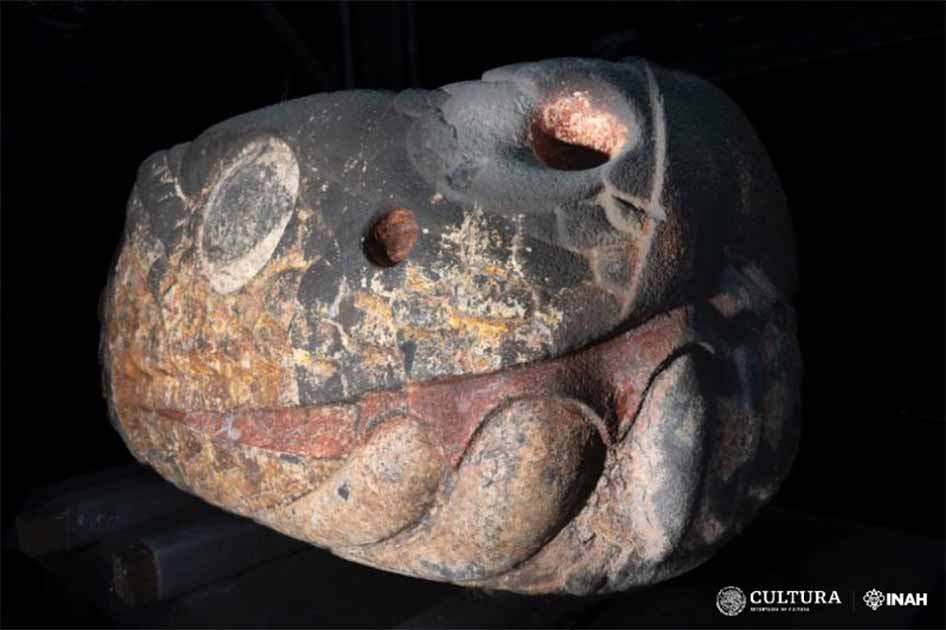Huge, Vibrant Snake Head from the Mexica Era Uncovered in Mexico City
In September 2022, beneath the surface of Mexico City and amidst the tremors of an earthquake, a massive stone-carved snake head emerged, believed to hail from the ancient Tenochtitlan era. Over a year later, the National Institute of Anthropology and History (INAH), supported by the UNAM specialists, is still diligently conserving this artifact, which holds a striking 80% of its original colorful surface, making it one of the most vibrantly preserved Mexica snake heads found to date.
This discovery took place beneath the eastern part of UNAM's (National Autonomous University of Mexico) former School of Jurisprudence building in Mexico City's Historic Center, reports INAH. Although displaced from its initial setting, the 1.2-ton sculpture, measuring 1.80 meters (5’ 8”) in length, 1 meter (3’ 4”) in height, and 85 centimeters (2’ 10”) in width, was found alongside various architectural components.
- The ‘Myth’ of the Plumed Serpent: Revealing the Real Message Behind the Feathered Snake
- An Ancient Maya City Founded by a God and Conquered by a Death Cheating Despot

INAH experts recover the polychrome of a monumental Mexica snake head. (LANCIC. UNAM/INAH)
Surprisingly, the very elements that concealed it for over 500 years - mud and water mixtures - also safeguarded its stucco and hints of its original colors: ocher, red, blue, black, and white.
After it had been excavated and removed, an expert conservation team, overseen by restorer María Barajas Rocha, initiated their preservation efforts. Barajas Rocha, renowned for her work on the goddess Tlaltecuhtli monolith found in 2006, emphasized the delicacy of the color conservation. The colors - showcasing the Mexica's vivid decorative palette - are fragile, derived from mineral and plant sources.
- Historic Atlantean Sculpture Unearthed at Chichén Itzá's New Zone
- El Caracol Conundrum: Secrets of Chichén Itzá’s Famous Maya Observatory

Using a humidity chamber, the ocher, blue, red, black and white tones with which it was painted in pre-Hispanic times are stabilized. (LANCIC. UNAM/INAH)
Mexica Snake Deity
The Mexica people, commonly known as the Aztecs, were an indigenous Mesoamerican civilization that flourished in central Mexico between the 14th and 16th centuries. Originating as a nomadic tribe in northern Mexico, they eventually migrated to the Basin of Mexico in the 13th century. There, they established their majestic capital city, Tenochtitlán, on the site of present-day Mexico City.
The Mexica snake deity, most commonly recognized as Quetzalcoatl, is one of the most prominent and revered gods in ancient Mesoamerican cultures, especially among the Aztecs. Quetzalcoatl is often depicted as a feathered serpent, blending the attributes of both a bird (quetzal) and a snake (coatl).
It should be noted, the snake head that has been found appears to have scales, rather than feathers.
This snake deity is associated with various aspects of Mesoamerican life, including knowledge, creation, wind, and fertility. In many myths, Quetzalcoatl is seen as a boundary-maker between the earth and the sky and is also credited with the creation of humanity by using his blood to give life to bones. Over time, the multifaceted nature of Quetzalcoatl has led to various interpretations and roles in different Mesoamerican cultures, yet he remains a symbol of the interconnection of terrestrial and celestial realms.
A Slow and Steady Preservation Process
In collaboration with UNAM, a humidity-controlled chamber has been set up, where, until early 2024, efforts to conserve the colors will persist. This environment ensures the moisture accumulated over centuries within the stone will slowly rise to the surface, minimizing any risk of color loss, cracks, or salt crystallizations.
Archaeologists Patricia Ledesma and Salvador Pulido have urged patience and understanding from both the media and the public. The stabilization process will continue into next year, during which the sculpture will remain off-limits, as any microclimate change could damage it.
Concurrently, UNAM's National Science Laboratory team will examine the carving's materials. Archaeologist Moramay Estrada Vázquez, the rescue project coordinator at the former School of Jurisprudence, is delving into research about the sculpture's historical context, its iconography, and symbolism.
Top image: Colorful, stone snake deity head recovered in Mexico City. Source: LANCIC. UNAM/INAH
By Gary Manners

















